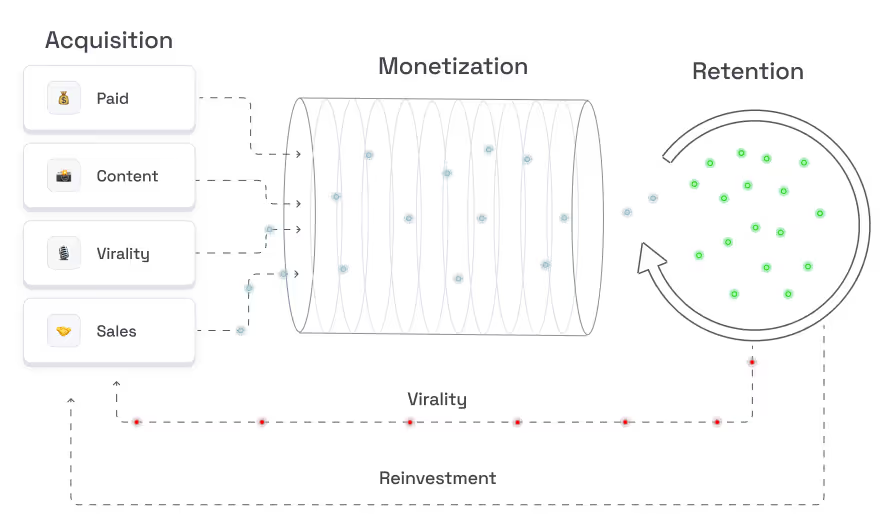
Conversation

🥳 Feedback Received!
Thanks for taking a moment to share your thoughts — it genuinely helps us make each chapter sharper.
What happens next:
- Your feedback goes straight to our product team.
- We’ll use it to refine lessons, clarify examples, and make the program even more useful.
Appreciate you helping make this program better for everyone.
Ready for your next challenge? 👇
Intro to B2C growth engine design
Where Your Engine Lives in Your System
Let’s zoom back out to the whole DC Growth System.
Growth Foundation → Growth Catalysts → Growth Engine (powered by Motions)
Parts 1–3: you built your foundation (Foundational Five + Catalysts), established your Guardrails, and prepped your messaging fuel via the Story System.
Now it’s time to build the machine itself.
Your growth engine is the system that builds on that foundation to create sustainable, compounding growth.
Most startups get stuck here. They confuse growth with “channels.” For example, let’s try content marketing and set up paid ads. But channels are just tactics. What we need to design first is the structure that those tactics fit into.
That structure is made up of motions.
Motions Power The Engine
Motions are the systematic approach used to achieve specific growth outcomes. The underlying mechanisms that power your engine.
And powering that engine are three motions:
- Acquisition Motions — how you bring new users into your ecosystem.Generally speaking, four types of acquisition motions are most effective for startups:
- Paid-led: renting exposure to someone else’s audience to push your message out to them.
- Content-led: pulling users in via valuable content.
- Virality-led: existing users bring in new ones.
- Sales-led: outbound prospecting and human conversations bring prospects in.
- Monetization Motions — how you turn users into paying customers and grow customer value over time.Here, every approach sits somewhere on the following spectrum:
- Product-led (aka “Self-serve”): users can purchase without going through a sales rep.
- Sales-led: sales teams guide prospects through the buying process.
- Hybrid: both self-serve and sales paths available to prospects.
- Retention Motions — how you activate users and keep them engaged.They share the same structures as monetization motions:
- Product-led: the product itself is the primary driver of retention.
- Sales-led: account managers and success teams are the primary drivers of customer satisfaction and retention.
- Hybrid: sales teams focus on larger accounts, while product drives retention for smaller accounts.
These are the systems that provide the structure for the channels, tools, and tactics you’ll build in the execution layer.
Side note: Why Three Motions Instead of “Go-to-Market”?
You’ve probably heard terms like product-led, self-serve, and/or sales-led GTM motions. Those are useful, but they only describe one piece of the puzzle. Generally, what the buying process looks like for customers. Or the monetization motion.
A sales-led GTM motion = A sales team is responsible for generating the sale. Put another way, a prospect must go through the sales process to make a purchase. While the product itself handles the conversion for a product-led GTM motion.
Again, useful. But incomplete. What they don’t answer:
- How do you get users in the first place?
- How do you keep them engaged and coming back?
- What else needs to happen to generate growth?
- As we’ll show below, very few companies are purely product- or sales-led. But the singular GTM motion concept certainly implies that’s the case.
Breaking our growth engine into three motions shows what’s actually happening under the hood. And increases the odds that we build each one intentionally to ensure they all work together.
How the Three Motions Work Together
And that’s the key insight: these motions aren’t separate lanes or independent systems. They’re interconnected. Each one fuels the others.

- Acquisition brings in users. The lifeblood that powers the rest of the engine.
- Monetization converts those users into paying customers and generates the fuel (revenue) to reinvest. That reinvestment might go into scaling acquisition and/or increasing core product value.
- Retention keeps customers engaged, which does two things:
- Extends monetization — the longer they stay, the more revenue you likely generate, and the better the opportunity for revenue expansion. This produces even more fuel.
- Feeds acquisition — retained customers drive referrals, reviews, and word of mouth that reduce CAC and accelerate growth.
When aligned, these motions create a compounding cycle: acquisition → monetization → retention → back into acquisition, stronger every turn.


